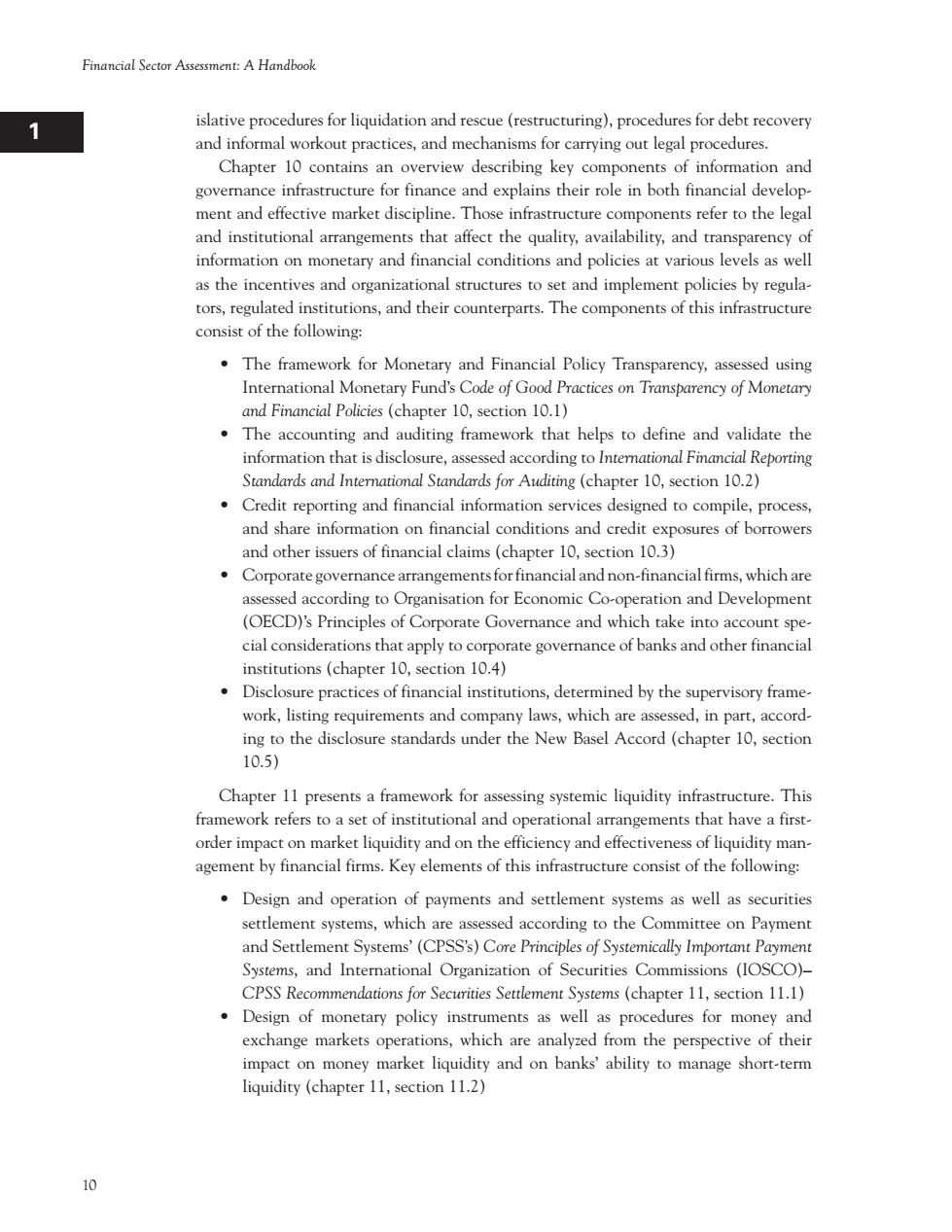正在加载图片...

Financial Sector Assessment:A Handbook islative procedures for liquidation and rescue (restructuring),procedures for debt recovery and informal workout practices,and mechanisms for carrying out legal procedures. Chapter 10 contains an overview describing key components of information and governance infrastructure for finance and explains their role in both financial develop ment and effective market discipline.Those infrastructure components refer to the lega and institutional arrangements that affect the quality,availability,and transparency of information on monetary and financial conditions and policies at various levels as well as the incentives and organizational structures to set and implement policies by regula- tors,regulated institutions,and their counterparts.The components of this infrastructure consist of the following: .The framework for Monetary and Financial Policy Transparency,assessed using International Monetary Fund's Code of Good Practices on Transparency of Monetary and Financial Policies (chapter 10,section 10.1) The accounting and auditing framework that helps to define and validate the information that is disclosure,assessed according to Intemational Financial Reporting Standards and International Standards for Auditing (chapter 10,section 10.2) .Credit reporting and financial information services designed to compile,process and share information on financial conditions and credit exposures of borrowers and other issuers of financial claims(chapter 10,section 10.3) Corporate governance arrangements for financial and non-financial firms,which are sed according to Organisation for Economic Co-operation and Developmen (OECD)'s Principles of Corporate Governance and which take in to account spe cial considerations that apply to corporate governance of banks and other financial institutions(chapter 10,section 10.4) .Disclosure practices of financial institutions,determined by the supervisory frame work,listing requirements compar y laws,which are ass sed,in part,accord ing to the disclosure standards under the New Basel Accord(chapter 10,section 10.5) Chapter 11 presents a framework for assessing systemic liquidity infrastructure.This framework refers to set of in stitutional and ngements that have a first order impact on market liquidity and on the efficiency and effectiveness of liquidity man- agement by financial firms.Key elements of this infrastructure consist of the following: .Design and operation of payments and settlement systems as well as securities settlement sys ems,which essed according to the Committee on Paymen and Settlement Systems(CPSS's)Core Principles of Systemically Impomant Paymen Systems,and International Organization of Securities Commissions (IOSCO) CPSS Recommendations for Securities Settlement Systems(chapter 11,section 11.1) Design of monetary policy instruments as well as procedures for money and exchange markets operations,which are analyzed from the perspective of thei impact on money market liquidity and on banks'ability to manage short-term liquidity (chapter 11,section 11.2)10 Financial Sector Assessment: A Handbook 1 I H G F E D C B A 12 11 10 9 8 7 6 5 4 3 2 islative procedures for liquidation and rescue (restructuring), procedures for debt recovery and informal workout practices, and mechanisms for carrying out legal procedures. Chapter 10 contains an overview describing key components of information and governance infrastructure for finance and explains their role in both financial development and effective market discipline. Those infrastructure components refer to the legal and institutional arrangements that affect the quality, availability, and transparency of information on monetary and financial conditions and policies at various levels as well as the incentives and organizational structures to set and implement policies by regulators, regulated institutions, and their counterparts. The components of this infrastructure consist of the following: • The framework for Monetary and Financial Policy Transparency, assessed using International Monetary Fund’s Code of Good Practices on Transparency of Monetary and Financial Policies (chapter 10, section 10.1) • The accounting and auditing framework that helps to define and validate the information that is disclosure, assessed according to International Financial Reporting Standards and International Standards for Auditing (chapter 10, section 10.2) • Credit reporting and financial information services designed to compile, process, and share information on financial conditions and credit exposures of borrowers and other issuers of financial claims (chapter 10, section 10.3) • Corporate governance arrangements for financial and non-financial firms, which are assessed according to Organisation for Economic Co-operation and Development (OECD)’s Principles of Corporate Governance and which take into account special considerations that apply to corporate governance of banks and other financial institutions (chapter 10, section 10.4) • Disclosure practices of financial institutions, determined by the supervisory framework, listing requirements and company laws, which are assessed, in part, according to the disclosure standards under the New Basel Accord (chapter 10, section 10.5) Chapter 11 presents a framework for assessing systemic liquidity infrastructure. This framework refers to a set of institutional and operational arrangements that have a firstorder impact on market liquidity and on the efficiency and effectiveness of liquidity management by financial firms. Key elements of this infrastructure consist of the following: • Design and operation of payments and settlement systems as well as securities settlement systems, which are assessed according to the Committee on Payment and Settlement Systems’ (CPSS’s) Core Principles of Systemically Important Payment Systems, and International Organization of Securities Commissions (IOSCO)– CPSS Recommendations for Securities Settlement Systems (chapter 11, section 11.1) • Design of monetary policy instruments as well as procedures for money and exchange markets operations, which are analyzed from the perspective of their impact on money market liquidity and on banks’ ability to manage short-term liquidity (chapter 11, section 11.2)